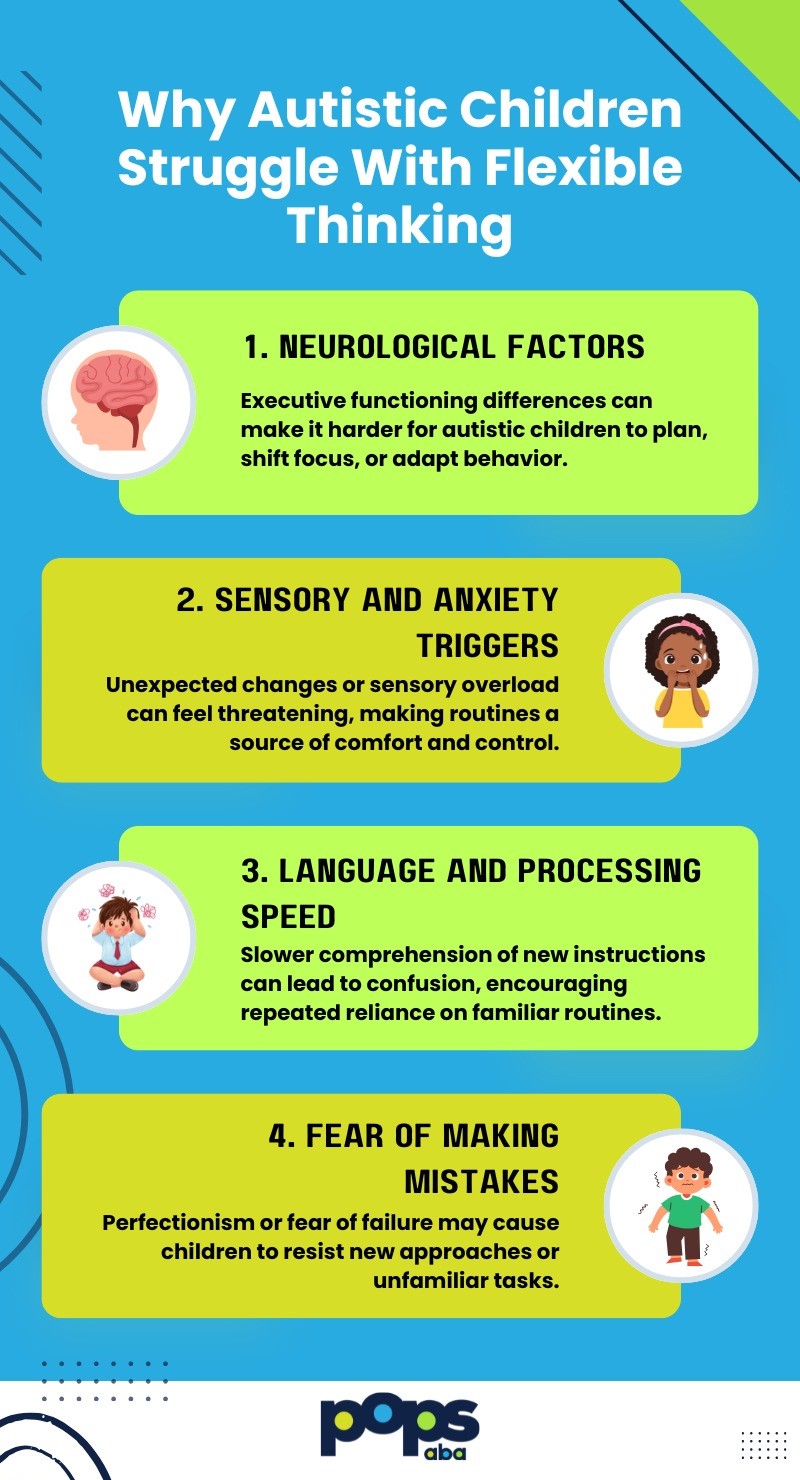Key Points:
- Flexible thinking in autism is the ability to adapt to changes and shift perspectives, which can be hard due to rigid routines and thought patterns.
- Teaching cognitive flexibility supports problem-solving, emotional regulation, and adaptability in daily life.
- Practical strategies include using visual supports, prompting choice-making, role-playing scenarios, and practicing gradual transitions.
Children on the autism spectrum often thrive on routine—yet the world rarely goes according to plan. Encouraging flexible thinking in autism helps them navigate surprises, learn new strategies, and handle transitions with less stress.
Developing cognitive flexibility isn’t about discarding comfort—it’s about gradually building the ability to adjust when things change. With the right tools, children can learn to shift gears, tolerate uncertainty, and choose responses rather than react automatically.
Is Flexible Thinking in Autism Learnable?
Yes, flexible thinking in autism is learnable with structured support and consistent practice. While many autistic individuals struggle with rigidity and adapting to change, targeted interventions can improve cognitive flexibility over time.
ABA therapy, visual supports, and role-playing activities help children shift perspectives, handle unexpected changes, and try new approaches. With the right strategies, flexible thinking can be strengthened, leading to better problem-solving, emotional regulation, and social interaction.
Why Do Children with Autism Struggle with Flexibility?
Before exploring strategies, it’s key to understand why flexible thinking is challenging. Children with autism often rely on routine for predictability, and changes can trigger anxiety.
Below are common factors that hinder flexible thinking in autistic children:

Instead of viewing rigidity as defiance, it’s more accurate to see it as a way a child copes with overwhelm. Teaching flexible thinking means gently expanding their comfort zone—task by task, environment by environment.
How Can Parents Tell If Their Child Struggles With Flexible Thinking?
Parents may notice their child struggles with flexible thinking if they have strong reactions to changes in routine, insist on doing things a certain way, or become upset when plans shift unexpectedly.
Other signs include difficulty with transitions, trouble adapting to new rules, or resistance to problem-solving tasks that require creativity or trying alternatives. These behaviors suggest the child may benefit from structured support to build flexibility and adaptability.
What Skills are Included in Flexible Thinking?
Flexible thinking isn’t just one skill—it’s a combination of cognitive abilities that allow a child to adapt, shift focus, manage frustration, and respond appropriately to change. For many children with autism, these executive functions develop more slowly, making transitions, surprises, or unfamiliar scenarios especially challenging.
Below are the core components of flexible thinking and how they support a child’s overall development:
1. Smooth Activity Transitions
Teaches children to shift attention from one task to another with less resistance, helping them handle daily changes, follow schedules, and move between activities more easily at home or school.
2. Adjusting to Change
Helps children accept when routines or plans shift unexpectedly by practicing flexibility, reducing anxiety, and improving their ability to cope with real-life changes in a calm and controlled way.
3. Managing Emotional Reactions
Supports emotional regulation when faced with surprises, delays, or mistakes, allowing children to respond with less frustration, fewer outbursts, and more adaptive coping strategies.
4. Trying New Solutions
Encourages experimentation and resilience by teaching that failure is part of learning, helping children try different strategies instead of giving up when something doesn’t work.
5. Understanding Others’ Views
Promotes perspective-taking by helping children consider other people’s thoughts and feelings, leading to more flexible thinking and smoother social interactions.
Developing these skills helps children move from rigid routines to dynamic problem-solving and calm adaptability in new settings.

How Can Parents and Therapists Teach Flexible Thinking?
Teaching flexibility starts small—with practice, structure, and encouragement. ABA techniques offer a clear roadmap. Before a task or lesson, tell the child what’s coming and what may change. This sets expectations and reduces uncertainty.
Effective strategies for building flexibility include:
1. Visual Schedules with Choice Points
Integrate small decisions into routines—like snack or play options—to give children structured control and encourage flexible thinking in everyday activities.
2. “First‑Then” Transitions
Use predictable visual prompts to prepare for change, helping children understand and accept what comes next with less resistance.
3. Role‑Playing Change Scenarios
Practice unexpected events through play to help children rehearse calm responses and problem-solving before real-life changes occur.
4. Social Stories About Change
Create stories showing characters facing changes and adapting, helping children visualize flexibility and develop coping strategies.
5. Gradual Schedule Changes
Introduce small changes with warnings and visuals, easing children into flexibility without overwhelming them or disrupting their routine.
6. Reinforcing Flexible Choices
Praise and reward moments when the child adapts, encouraging them to try new approaches and embrace change with confidence.
Each of these strategies builds flexible thinking in a developmentally appropriate way—rooted in routine but open to change.
When Should Flexible Thinking Strategies Be Introduced?
Flexible thinking strategies should be introduced early, as soon as a child begins showing difficulty with transitions, changes, or problem-solving. Early intervention helps prevent rigid patterns from becoming deeply ingrained.
By incorporating flexible thinking into everyday routines, parents and therapists can build adaptive skills gradually. Introducing these strategies during calm, teachable moments—rather than during stress—allows children to practice flexibility in a supportive, low-pressure environment.
What Mistakes Should Caregivers Avoid?
Caregivers should avoid forcing flexibility during moments of distress, as this can increase anxiety and resistance. Introducing change without warning may also overwhelm the child and lead to challenging behaviors.
Another common mistake is being inconsistent with routines or expectations. While flexibility is the goal, children need structure to feel safe. Successful flexible thinking strategies balance predictability with gentle variation, introduced gradually and reinforced with encouragement.
Support Lasting Growth With ABA Therapy
At Pops ABA, we specialize in teaching flexible thinking in autism using structured, compassionate methods. We help children adapt to change, manage transitions, and embrace new routines with confidence and skill.
We offer ABA therapy in North Carolina and New Jersey, with tailored strategies to teach cognitive flexibility at home, school, and in the community. Get in touch with us to learn how flexible thinking training can help your child thrive in a changing world.



